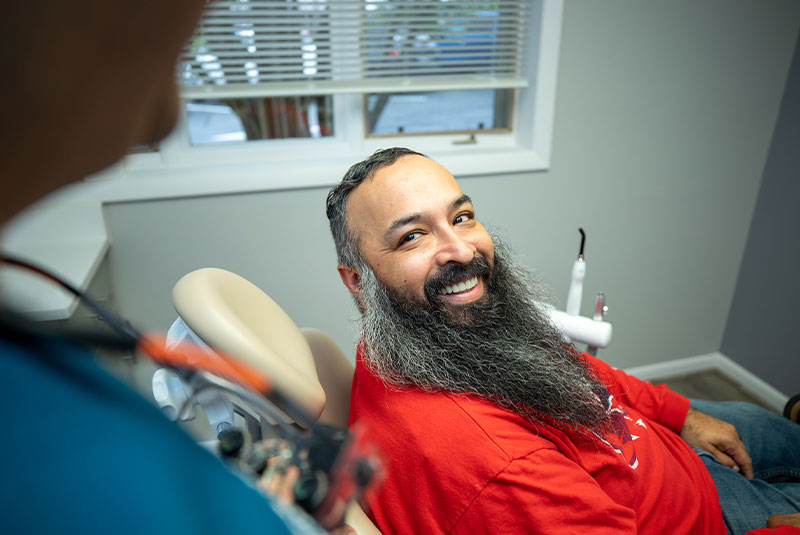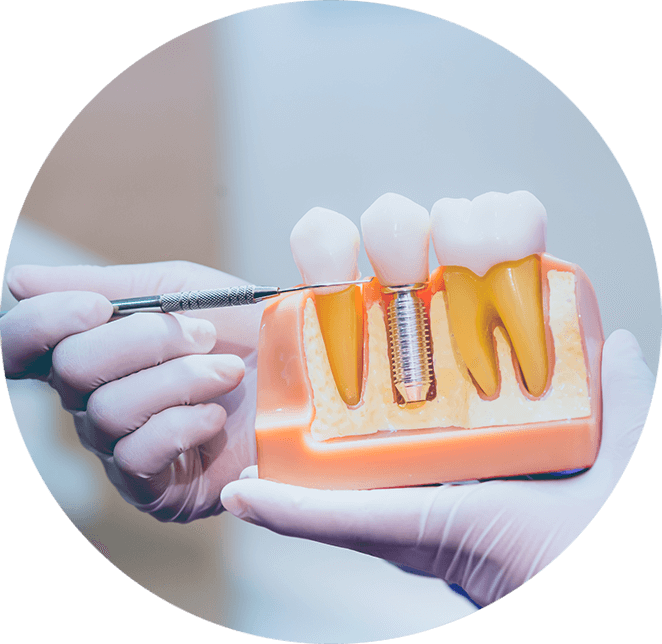

If you’ve suffered dental trauma or are living with a toothache, you may need a tooth extraction to truly preserve your smile. A damaged or abscessed tooth can quickly lead to more serious issues affecting your other teeth, oral health, and even in some cases, your physical health if the cause is gum disease. At Woodbridge Periodontal and Implant Center, we’ll always first recommend treating infection and saving a natural tooth with services like deep cleanings or a root canal. However, if unresponsive, removal may be the only way to restore your health.
Our periodontist is uniquely qualified to remove teeth and has the skill to minimize damage to your bone and gums.
Our periodontist provides gentle tooth extractions in Fairfax & Woodbridge, VA to quickly remedy your pain and save your smile from unnecessary harm. Considered experts in tooth extractions, periodontists have specialized training in hard and soft tissue treatments. Our periodontist is uniquely qualified to remove teeth and has the skill to minimize damage to your bone and gums. You’ll benefit long-term from seeking treatment at Woodbridge Periodontal and Implant Center! With sedation dentistry, a relaxing atmosphere, and affordable pricing, we’ll make your tooth extraction, and the path to restored health, surprisingly simple.
During your initial consultation, we’ll examine your problem tooth or teeth and determine if a tooth extraction is needed. We’re in-network with multiple leading insurance providers and will work with you to not only determine the best solution for your health but your finances as well. If you’re scheduled for tooth extraction in Fairfax & Woodbridge, VA, this means we were unable to preserve your natural tooth with more conservative measures or have deemed it unsalvageable due to infection, trauma, or another cause. For most patients, tooth extraction is an efficient and fast surgery that won’t cause you pain. Our patients report that though they experienced a slight pressure during the procedure, they remained comfortable and relaxed at their appointment.
After you arrive for your tooth extraction procedure at our Fairfax & Woodbridge, VA practice, we’ll first ensure you are comfortable and then numb the gums around your tooth with a local anesthetic. Next, we’ll use forceps to grasp your tooth and gently remove it, being careful to not harm adjacent teeth or bone and gum tissue at the site. Our periodontist and dental team routinely complete tooth extraction procedures and are skilled in making them efficient and pain-free. Before you know it, your procedure will be complete! Your healing period will last a few days, during which time you may take over-the-counter medication for any discomfort. We’ll review post-operative instructions and recommendations with you in detail to ensure a healthy and comfortable recovery.


After any tooth extraction, it’s critical that you take special steps to ensure the healing process goes as it should. A blood clot typically forms over an empty tooth socket during healing. If this doesn’t happen or if the blood clot is removed, the bone and nerves below the socket become exposed. This results in a painful complication called dry socket. You can prevent dry socket and ensure a smooth recovery by following the post-extraction guidelines we’ll review in detail with you after your surgery.
Your tooth extraction shouldn’t be the last stage of your treatment, though. We recommend many patients replace their extracted tooth, and generally encourage dental implants. The only permanent tooth replacement, dental implants look and act just like natural teeth due to their similar structure—post (tooth root) and restoration (tooth crown). This tooth will look identical to your natural teeth and provide all the same functional benefits. It’ll be as if you’d never had a tooth extracted in the first place!
I understand the information disclosed in this form may be subject to re-disclosure and may no longer be protected by HIPAA privacy regulations and the HITECH Act.
New Patients:
(703) 436-1316
Current Patients:
(703) 491-2974
Address:
2200 Opitz Blvd #205,
Woodbridge, VA 22191
Office Hours
Monday | 8:00am – 5:00pm
Tuesday | 8:00am – 5:00pm
Wednesday | 8:00am – 5:00pm
Thursday | 8:00am – 5:00pm
Friday | Closed
New Patients:
(703) 570-4800
Current Patients:
(703) 570-4802
Address:
8622 Lee Hwy, Unit D
Fairfax, VA 22031
Office Hours
Monday | Closed
Tuesday | 8:30am – 5pm
Wednesday | Closed
Thursday | Closed
Friday | Closed
Saturday | Closed
Sunday | Closed
